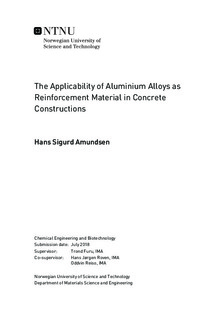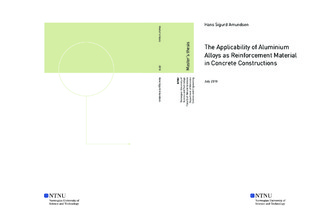| dc.description.abstract | This thesis is a part of the DARE2C research project. The research projects primary objective is to develop a more environmentally-friendly type of concrete where more than 55% of the cement is replaced with less CO2(g) intensive supplementary cementitious materials (SCMs) and aluminium is used as reinforcement material, instead of steel. The major reason of why aluminium is not used as reinforcement material in concrete today is first and foremost because aluminium and its alloys will corrode in the highly alkaline environment that is produced in the concrete during the cement hydration reaction. Through a multidisciplinary collaboration together with three civil engineering students, a set of concrete beams incorporated with inhibitor protected Al-5Mg reinforcement were manufactured and subjected to a 4-point bend test. All of the reinforced concrete beams experienced anchorage failure where the reinforcement slipped inside the concrete due to poor adhesion but behaved mechanically similar as ordinary steel reinforcement before the failure. No corrosion was observed on the reinforcement surfaces which means the aluminium is chemically compatible with the concrete, but in order to conclude the applicability of aluminium as reinforcement further studies has to be conducted where the aluminium rebars need to be designed with a deformation pattern to obtain better adhesion.
An experimental procedure to measure gas development from the corrosion reaction was conducted on different alloys to determine the corrosion resistance with the inhibitor and its efficiency. The conclusion from this experiment was that a longer exposure time of the aluminium in the inhibitor solution seemed to increase the efficiency of the inhibitor and thereby increasing the corrosion resistance. Further studies must be performed to determine the mechanisms of the inhibitor and to identify the new protective oxide layer formed on the aluminium surface. Since this inhibitor is to be patented, the identity and possible mechanism will remain secret.
Two additional contributing reasons of why aluminium is not used as reinforcement material in concrete are firstly the inferior mechanical properties compared to steel and secondly high values of the coefficient of linear thermal expansion (CTE) in comparison to concrete. Aluminium has generally low stiffness and strength compared to steel, but by extruding the aluminium into specific geometries may compensate for the low Young s modulus. Improving the inhibitor may enable the use of alloys which are responsive to heat treatments and can obtain almost similar strength as compared to steel. Different CTE values between reinforcement materials and concrete exposed to large temperature differences can cause the reinforcement material to expand at higher rates than the concrete which may lead to loss of adhesion between the two materials and cracking and spalling of the concrete. The CTE was measured with use of a push-rod dilatometry technique and manual technique with an extensometer. The results obtained from the thermodilatometry was measured to be close to the literature values, but contained some uncertainties". Measuring CTE manually with an extensometer was unsuccessful. It was found that under normal operating temperature, CTE would not be a problem. Therefore, the focus should be directed to implementing high strength alloys rather than alloys with low CTE in concrete.
Two Al-Mg alloys and two Al-Si alloys were studied in this thesis, where they were subjected to thermomechanical processing, followed by examinations of their mechanical properties, microstructure and corrosion properties through a variety of metallurgical methods. In addition, a feasibility study was conducted where the possibility of recycling aluminium from old car engines through the novel method of screw extrusion and using it as reinforcement material in concrete was investigated. Insufficient cleaning of oil residue from the engine material and suboptimal run parameters resulted in poor quality of the surface of the produced profile. By improving the operating parameters during the screw extrusion process and improving the efficiency of the inhibitor, there is a possibility that this type of recycled material can be used as an environmentally friendly reinforcement material in concrete. | |

